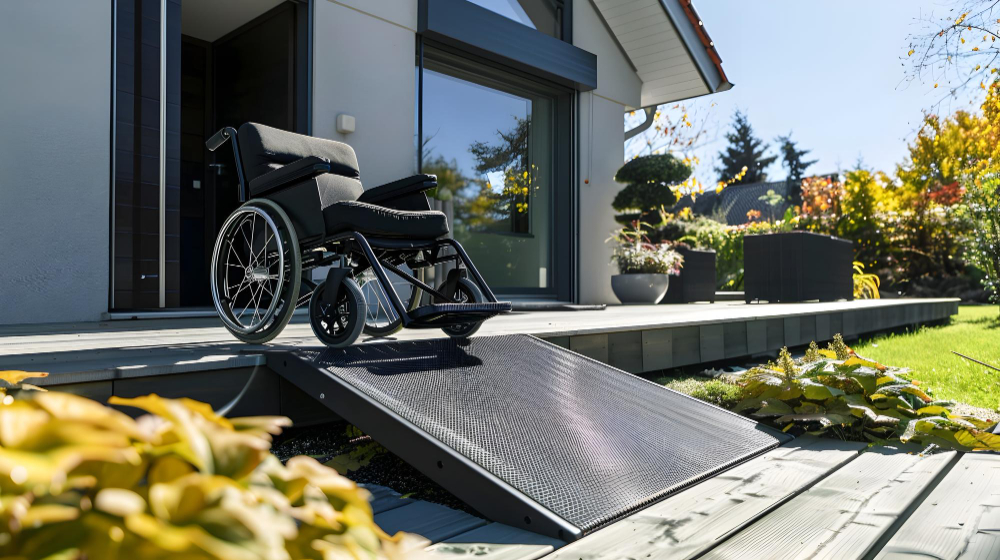What Is The Best Wheelchair Ramp For Home Use?
- 5 Types Of Wheelchair Ramps
- Choosing The Right Wheelchair Ramp
- Special Considerations For Home Wheelchair Ramps In South Florida
- Who Would Benefit From A Home Wheelchair Ramp?
- How To Choose A Home Wheelchair Ramp
- When To Upgrade Or Replace A Wheelchair Ramp
- Wheelchair Ramps at Affordable Medical Supply
Everyone should be able to access every area of their home safely. One of the most effective ways to ensure both accessibility and independence for those with mobility challenges is by installing a wheelchair ramp. Whether you are recovering from surgery or have a physical condition that limits your mobility, a well-designed wheelchair ramp can transform your life.
Taking South Florida’s challenging weather conditions into account, choosing the best wheelchair ramp for home use needs careful consideration. There are a variety of wheelchair ramps available, and some key features that need to be considered before deciding on which one to buy.

5 Types Of Wheelchair Ramps
When it comes to wheelchair ramps for home use, one size does not fit all. Below are some popular wheelchair ramp types.
1. Threshold Ramps
These wheelchair ramps are best for small elevations at doorways and sliding doors. Usually made from rubber, aluminum, or plastic. They are easy to install, usually low-cost, durable, and slip-resistant. The disadvantage of a threshold ramp is that it is only suitable for risers of up to a few inches.
2. Portable Ramps
Portable ramps are ideal for temporary access or travel. They are most commonly made from aluminum. and have the advantage of:
- Being lightweight and foldable
- Easy to store and transport
3. Modular Ramps
These wheelchair ramps are best for semi-permanent or custom applications. Usually made from aluminum, they are:
- Able to be fully customized
- ADA compliant
- Durable and weather-resistant
- Easily moved or relocated
Keep in mind that modular ramps require extra planning for installation.
4. Wooden Ramps
Wooden ramps are best used for permanent installation and for those who have aesthetic preferences. Wooden ramps are primarily made out of treated lumber and have the following advantages:
- They can be manufactured to match the home exterior
- Can be custom-built to fit the location
Wooden wheelchair ramps require regular sealing and maintenance. They can also be quite slippery when wet, and are prone to rot and infestation if not properly maintained.
5. Concrete Ramps
Concrete ramps are best used for long-term or permanent access needs. They are known to be durable and require minimal maintenance.

Choosing The Right Wheelchair Ramp
Before deciding on what type of wheelchair ramp will be required, it is essential that homeowners:
- Take accurate measurements, including the total rise from the ground to the entry point
- Plan the path and avoid steep slopes by trying to make use of gradual inclines where possible
- Obtain the necessary building permits and approval for an ADA (Americans with Disabilities Act) compliant wheelchair ramp
- Choose a solid foundation, which is especially important in South Florida’s sandy and flood-prone soil
- Ensure that the ramp is adequately secure against hurricanes and extreme weather. Hurricane-rated anchors and brackets will be needed
- Consider lighting, as it may be essential for nighttime visibility and safety
- Budget for routine inspections and maintenance, especially after heavy rains or hurricanes. This will ensure that the ramp remains in the best condition.
Special Considerations For Home Wheelchair Ramps In South Florida
South Florida residents must account for some unique environmental and regional factors before deciding on a wheelchair ramp for their home.
Some of these considerations include:
- Climate and weather – Florida is well known for its high humidity and heavy rainfall, especially in June through October, so the materials must be able to resist rust, rot, and mold.
- Building codes – South Florida has strict local building codes, especially in flood and hurricane-prone areas. Before building a ramp, always check that you will be adhering to the local building code
- Pest Control – wooden ramps in South Florida may attract termites and ants if not treated correctly.
With South Florida’s high humidity and heavy rains, extra thought needs to be put into the construction of wheelchair ramps.
Professionals will advise homeowners to consider:
- Rubber threshold wheelchair ramps are ideal for South Florida’s humid climate, as they are known to resist mold and do not corrode.
- Ensuring that the ramp has a non-slip surface is essential to prevent accidents during the rainy season
- Modular and new aluminum ramps with powder-coated finishes can withstand the moisture and salt air, especially if they are installed near the coast
- When it comes to wooden ramps, only pressure-treated and sealed wood should be used. All wooden ramps need to be regularly inspected for termite damage.
- Adding texture to concrete ramps will improve the grip during wet conditions.
General features to look for in a wheelchair ramp are:
- A non-slip surface
- A drainage design that will ensure water doesn’t pool on the ramp
- The ramp must withstand the weight capacity for which it will be used. The ramp should be able to support both the user and any mobility device, including electric wheelchairs.
- Edge protection will prevent wheelchairs or walkers from slipping off the side of the ramp
- Handrails are important for user safety and stability. They are mandatory for longer or steeper ramps.
Who Would Benefit From A Home Wheelchair Ramp?
Wheelchair ramps make it easier and safer for people with mobility challenges to both enter and exit the home, and to access various levels of a multi-level home.
Wheelchair ramps are not only for individuals who use wheelchairs; many people can benefit from a wheelchair ramp, including:
- People recovering from surgery, like hip replacement, knee Replacements, or back operations
- Individuals who use walkers or canes
- Caregivers who assist individuals who have mobility challenges
- Any individual with developmental or neurological disabilities that affect mobility
- Individuals with chronic conditions like Parkinson’s disease, arthritis, and multiple sclerosis that impact their mobility
- Parents with young children who still use strollers
- Individuals with temporary injuries, like a broken leg or sprained ankle
- Individuals with balance issues like vertigo
- Any individual who is generally weak or suffering from fatigue
How To Choose A Home Wheelchair Ramp
There are some key things to consider before deciding on what ramp you are going to be installing in your home. Some issues to take into account include, among others:
- The user’s needs. When choosing a ramp, one needs to take into account the strength, dexterity, and other physical limitations that the user may have. Will the user going to be using the ramp for a wheelchair, a scooter, or will they be only needing it for walkers and canes?
- How often will the ramp be used? Before deciding on which ramp is best, you need to decide if you are going to be using this ramp daily and regularly, or if it is going to be in an area where it is only used occasionally.
- Budget – When consulting a professional, you will be given various options of materials and safety features. You need to go with the best ramp that your budget can allow.
- Ramp placement:
- Where is this ramp going to be needed/placed? Is it for your front door, your garage, a side entry, or a patio?
- Will there be enough space for the required slope?
- Will this ramp be a temporary fixture or will it be for permanent use? Permanent ramps are ideal for individuals with long-term needs. Portable or modular ramps are great for temporary recovery or those requiring a ramp for a limited time.
- ADA compliance. Even if you are installing a ramp for individual use, following the ADA (Americans with Disabilities Act) guidelines will ensure that the ramp has all the safety features for secure accessibility.
When To Upgrade Or Replace A Wheelchair Ramp
Professionals always advise that homeowners maintain the wheelchair ramps regularly. They should consider upgrading or replacing the wheelchair ramp if:
- The surface looks worn, faded, or cracked
- The ramp starts warping. This is especially relevant in wooden ramps after heavy rainfalls
- The ramp starts to rest or corrode. Aluminum and steel ramps need to be checked regularly
- The mobility needs increase. If the user, for example, starts transitioning from a walker to a powered wheelchair, the ramp may no longer be suitable.
- If the user notices loose fittings or anything that looks broken or cracked, professionals should be consulted to either repair or replace the ramp.
Wheelchair Ramps at Affordable Medical Supply
Whether you’re looking for a simple wheelchair ramp solution or a custom modular system, getting professional advice is essential. With over 45 years working in the medical supply industry, we can help you pick out the perfect wheelchair ramp and accessories for you or your loved one’s needs! Mobility is important, don’t wait!
For professional help, contact Affordable Medical Supply at 866-484-7599 today.




